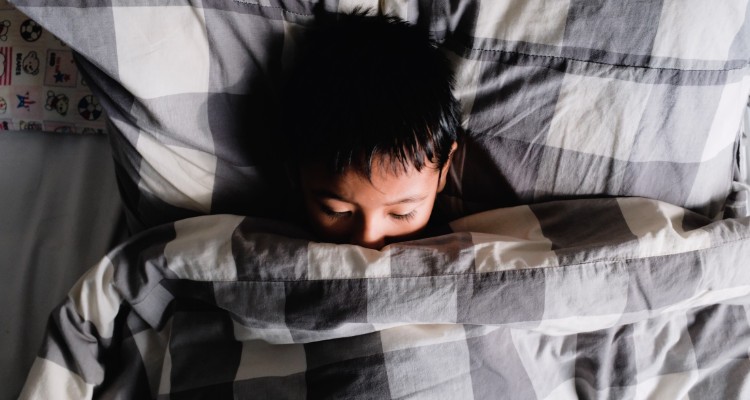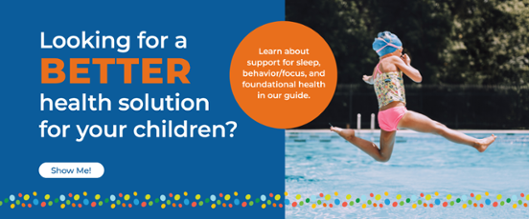
Sleep issues are quite prevalent in children, which likely doesn’t come as a shock to many parents. But disrupted sleeping patterns can have ripple effects that impact school performance, daytime behavior, physical health, overall family dynamics, and more.
When children take 30 minutes or more to fall asleep, if they consistently get less than eight hours of sleep, or if their quality of sleep is poor, they may develop sleep issues that are challenging to overcome. With children, it’s important to understand that their sleep issues are negatively impacting how they function during the day, their health, and their emotional well-being, among other factors.
Sleep challenges can be expressed by increased irritability, anxiousness, low mood, hyperactivity, and problems focusing at school. However, there are ways to improve a child’s quality of sleep. Liquid melatonin combined with healthy sleep hygiene practices – when good sleep hygiene doesn’t work alone– can be a very effective strategy to lay the foundation for healthy long-term sleeping habits in children.*
Melatonin 101
Melatonin is a sleep hormone produced in the pineal gland. It is excreted in larger amounts when it’s dark, following the natural circadian rhythm of the sun. When working optimally, the body’s melatonin levels should naturally increase at nighttime, allowing the body to fall asleep.
An important distinction to make is that melatonin in supplement form does not function like any other type of sleeping aid. Rather than inducing someone to fall asleep, melatonin simply sends signals that prepare the body to be ready for sleep.

Sleep Hygiene for Kids
While melatonin has been found to be safe for short-term use in children, it’s always best to start with proper sleep hygiene practices. The following strategies can help naturally foster healthy sleeping habits for kids:
- Have a regular bedtime every night of the week.
- Create a regular bedtime routine—for example, a bath or shower, a relaxing lotion, and massage, or a book or lullaby. Do whatever works for your family, but it should happen within about 30 minutes before bed. A routine that lasts too long can make it harder to fall asleep.
- Skip daytime naps for school-aged kids.
- Encourage children to sleep through the whole night in their own bed, instead of falling asleep on the couch or in a parent’s bed.
- Be sure the bed is only for sleeping—not for homework, playing, or other activities.
- Create a dark sleeping environment. Too many lights can impact melatonin production.
- Keep the bedroom cool, ideally between 60-68 degrees.
- Don’t allow any screen time for at least one hour before bedtime, if not more.
- Try to have dinner two hours before bedtime to ensure that digestion doesn’t disrupt sleep.
If parents have already tried establishing sleep hygiene practices and routines without success and sleep issues have become chronic, the combination of continued healthy bedtime routines and the use of melatonin can be very effective.*
Why Liquid Melatonin?
Melatonin in liquid form tends to be superior for children, especially as a dropper or spray. This method of administration allows for consistent administration and quick, optimal absorption. Liquid melatonin is also much easier for children to take compared to capsules or tablets. Even with chewable or gummy forms, you can’t always ensure how well the melatonin will be digested and absorbed.
Timing and Amount
Success has been seen using higher amounts with children who have specific mental or physical challenges. However, for general sleep issues, studies have found that a dose of 2-3mg for children under 40kg is recommended, and up to 5mg for those over 40kg.* Some research also suggests starting with a low dose of 1mg before increasing as needed.
As with any supplementation, it’s always best to discuss the right amount for your child with a trusted healthcare provider. In terms of timing, it’s best to take melatonin 30-60 minutes before bedtime.¹
Who Might Not Benefit from Melatonin?
If another underlying issue is causing sleep problems, melatonin is unlikely to be effective. For example, children with night terrors, sleepwalking, or another form of sleep disruption will probably not benefit from melatonin. Others may struggle with sleep due to underlying issues that cause physical discomfort, which often leads to tossing and turning. If this is the case, it’s important to talk with a pediatrician or chiropractor to get to the root of the problem.
Current research shows that melatonin is effective for short-term use in children.² Short-term use of liquid melatonin and proper sleep hygiene is often enough to reset sleep patterns in children.* If the combination of melatonin and sleep hygiene isn’t working, it’s important to work with a pediatrician, naturopathic doctor, nutritionist, or other integrative practitioner to consider underlying issues.
Many parents are concerned about their child’s sleep quality, and for good reason. The common issue of poor sleep can have a huge impact on a child’s happiness, performance, and overall health. But there are steps parents can take. By using liquid melatonin to help reset their circadien rhythm and encouraging effective and consistent sleeping habits, parents can help keep their child happy, healthy, and sleeping properly.*

*These statements have not been evaluated by the Food and Drug Administration. This product is not intended to diagnose, treat, cure or prevent any disease.
Stephanie O’Neill Bhogal DC, DICCP did her undergraduate studies at McGill University in Montreal,
Canada and received her DC degree from Palmer College in Davenport, IA in 2002. She completed her
Pediatrics residency at Palmer College in 2005 when she also received her Diplomate in Clinical
Chiropractic Pediatrics (DICCP). Dr. O’Neill has taught Obstetrics and Pediatrics at both Palmer college
of Chiropractic and Life Chiropractic College West. With 17 years of professional experience, both
teaching and in private practice, her focus is on routine and complex pediatric and pregnancy care. Dr.
O’Neill presents regularly at national and international conferences. She also teaches in the ICA
(International Chiropractors Association) Pediatric Diplomate program and is proud to serve as the chair
of the ICA Council on Chiropractic Pediatrics. Dr. O’Neill enjoys travelling and service through Peak
Potential Outreach, a non-profit foundation she and her husband founded to provide healthcare to
underserved countries around the world.
Sources:
1 “Effects of melatonin and bright light treatment in childhood chronic sleep-onset insomnia with late melatonin onset: a randomized controlled study.” 2017. https://academic.oup.com/sleep/article/40/2/zsw038/2666484. Accessed November 2, 2019.
2“Sleep-related melatonin use in healthy children.” 2016. https://www.ncbi.nlm.nih.gov/pmc/articles/PMC4830653/. Accessed November 2, 2019.











-1.jpg)






